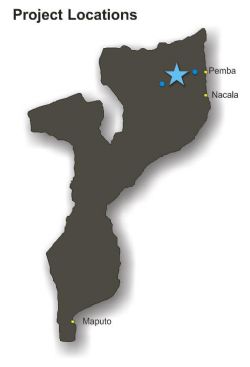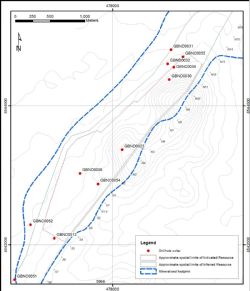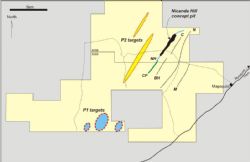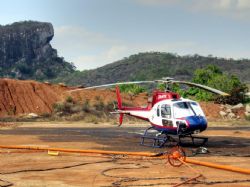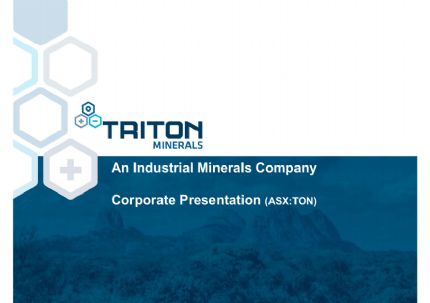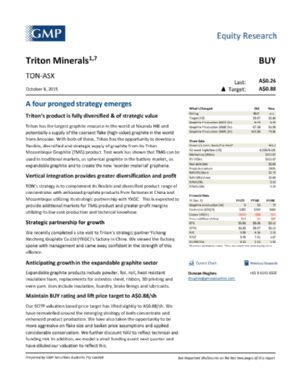
Nicanda Hill Update
Perth, Nov 28, 2014 AEST (ABN Newswire) - Triton Minerals Limited ( ASX:TON) (Triton, Company) is pleased to provide updated metallurgical and drill results on the world's largest graphite and vanadium deposit at Nicanda Hill, in the Balama North project in Mozambique.
ASX:TON) (Triton, Company) is pleased to provide updated metallurgical and drill results on the world's largest graphite and vanadium deposit at Nicanda Hill, in the Balama North project in Mozambique.
Triton Minerals Managing Director Brad Boyle said: "These latest metallurgical and drilling results continue to strengthen Triton's understanding of the diverse range of features of the graphite material contained within the Nicanda Hill resource."
SIGNIFICANT ASSAY RESULTS
As previously advised on 21 October 2014, Triton completed its 2014 initial exploratory drilling program at the Nicanda Hill deposit which culminated in the release of a maiden JORC 2012 mineral resource at Nicanda Hill.
In defining the world's largest graphite and vanadium deposit at Nicanda Hill, a total of 46 drill holes, for which assays were available, were used in the mineral resource estimation.
Since the release of the maiden JORC 2012 mineral resource in October and subsequent update on 30 October 2014, the Company is pleased to advise that additional significant drill results for the RC and diamond drill holes completed during the drilling program have been received.
Approximately, 75% of the drill core assays have now been received from the laboratories. Triton confirms a number of drill core intercepts have been in excess of 20% TGC. Table 1 in link below shows the weighted average graphite carbon of the significant drill result intervals.
As anticipated, higher grade material is now confirmed consistently along strike either at or near surface within the Nicanda Hill deposit. With these additional results the morphology, location and characteristics of the >15%TGC material is becoming better understood. Future drilling will be targeted to improve the extents and classification of these higher grade graphite zones.
The delineation of the graphite zones in excess of 15% TGC, will assist in the selective mining of higher grade areas, which is likely to improve the overall economics of the already robust and commercially viable Nicanda Hill graphite deposit.
METALLURGICAL RESULTS
OVERVIEW
Triton has received additional information relating to its initial metallurgical test work undertaken by ALS Laboratories (Adelaide) and acquired from a limited number of preliminary samples taken from a single location within the Nicanda Hill deposit.
The latest results have again confirmed that the Nicanda Hill graphite ore, through standard flotation methods, is readily able to produce graphite concentrates which assay from 95.8%TGC to 97.3%TGC.
The entire database of initial metallurgical test work results will form the basis and framework of a more detailed metallurgical review of a broader range of samples that have been obtained from multiple sites across the mineralised footprint.
The results from the on-going metallurgical program, currently being undertaken by Mintek (Johannesburg), will be incorporated into the forthcoming feasibility program. This new program will include variability metallurgical testing to identify and confirm larger areas of near-surface large flake graphite material and to verify the methodology for the optimisation in the recovery of the various graphite flake sizes.
IMPURITIES SHOWN TO BE INSIGNIFICANT
The metallurgical results confirm that the graphitic concentrate produced through the standard flotation methods contain low levels of impurities, which means the graphite is liberating cleanly from the graphitic ore.
The tests verify low levels of volatiles and impurities. The impurities are mainly silica in the form quartz followed by anorthite and muscovite, which can be readily separated without having any detrimental impact on the quality of the graphite concentrate.
These flotation tests produced graphite concentrates with a weighted average purity of 97.1%TGC, 2.7% Ash and 0.2% Volatiles, without the need for chemical treatment.
HIGH PURITY (99.9%) GRAPHITE PRODUCED IN LABORATORY TESTING
The metallurgical tests have found that Triton is able to upgrade the graphite concentrate up to 99.9%C using simple chemical wash.
To upgrade graphite flotation concentrate, samples were digested in 20% solution of hydrochloric acid (HCl) at 20% solids (w/w) for 4 hours at 80ºC in a water bath to remove carbonate and iron oxides. The residue was then thoroughly washed to remove all acid and leached in 8% solution of hydrofluoric acid (HF) at 20% solids (w/w) for 4 hours at 90ºC to remove silicates. The final residue was thoroughly washed, dried and assayed for graphitic carbon.
Leaching is a very effective method to remove gangue minerals from graphite concentrate without flake size reduction. The amount of consumables required for the purification process is very low due to the very high grade of the graphite concentrate and the low levels of the impurities which can be readily removed.
VANADIUM & ZINC RECOVERY
Metallurgical test work to date shows that both vanadium and zinc are present at significant levels in the process tailings after the flotation and separation of the graphite concentrate from the ore. Also of note is the presence of other base metals, including titanium, in the tailings.
In the initial testing vanadium was readily upgraded through a standard flotation of graphite tailings to produce vanadium concentrate with grades up to 0.74% V2O5.
A zinc concentrate assaying 7% was also produced from the graphite tail through simple flotation process.
Further metallurgical investigations are required in order to optimise flotation conditions and improve both vanadium and zinc recoveries so that they may be further upgraded. Accordingly, the vanadium and zinc potential of the Nicanda Hill resource is still to be fully understood.
Should the vanadium and zinc be found to be upgradable from the tailings as a saleable concentrate, this would have a major positive impact on the overall economics and profitability of a potential mine at Nicanda Hill.
GRAPHITE PRODUCTS
The latest results contained within this announcement confirm that high purity graphite in excess of 99%TGC can be readily achieved. Together with the positive independent Scoping Study report, announced on 26 November 2014, the high quality nature of the Nicanda material enables Triton to further review options and conduct additional research into the potential uses of the Nicanda Hill graphite.
As previously announced, some of the options being considered by Triton include: Expandable Graphite (insulation foam, soft foams, mattresses, carpets, textiles, coatings, plastic foils, rubber products, Pipe closing systems, fire retardants, graphite foil), Micronised Graphite Powder (photovoltaic, high temperature furnaces, lamp carbon, lubricants, carbon brushes), Spherical Graphite (anodes in lithium ion batteries) and Recarburisation (steel making and iron casting).
NEW EXPLORATION TARGETS
Airborne geophysical (VTEM) surveys have now been completed over the Ancuabe and Balama South project licenses. An additional survey was completed on a previously un-surveyed portions of the Balama North project located to the west of the Nicanda Hill and Cobra Plains deposits.
Whilst the majority of the survey data is still being processed and finalised, Triton is pleased to confirm that new large and significant conductive responses (typical of high grade graphite mineralisation) have been identified in the southern and western portions of Licenses 5966 and 5365.
Target area P1 (Figure 2 in link below) is particularly significant as it appears to form a satellite mineralized body along strike from and along the same trend as the Nicanda Hill deposit. These additional targets offer Triton the opportunity to test for additional near-surface high grade graphite (>15%TGC) and with possibly different mineralogical characteristics to provide even more variety in the type of graphite concentrates that can be produced to cater for differing customers' requirements. The new anomalies will become priority targets for the Company in future drilling programs.
CONCLUSIONS
Triton controls the largest known graphite-vanadium deposit in the world at the Nicanda Hill deposit.
The Scoping Study results announced on 26 November 2014, highlight that Nicanda Hill graphite deposit is commercially viable, base-case operation comprising shallow open pit/ conventional crushing-grinding- deposit flotation production - low technical risk.
Initial metallurgical test work confirms:
- High purity graphite concentrate of 94-97%TGC may be produced on site through simple flotation
- Exceptional purity of 99.9%C achievable from graphite concentrate
- Vanadium and zinc occur as credits and may be recovered as a concentrate without difficulty
- Vanadium concentrate grades of up to 0.74% V2O5 achieved to date
- Zinc concentrate grades of up to 7%Zn achieved to date
Triton notes these latest drill and metallurgical results are subsequent to those incorporated in the Mineral Resource estimate and the Scoping Study results. They reflect the on-going commitment by the Company to rapidly refine and improve the overall economics and profitability of the proposed graphite mine at Nicanda Hill, including the vanadium and zinc potential, and to complete the feasibility studies on the project as soon as practicable.
Nicanda Hill has the potential to become the world's lowest cost and most reliable producer of high quality flake graphite.
Finally, the identification of further exploration targets suggest that this current multi-element resource at Nicanda Hill could be potentially supplemented by additional high quality near-surface graphite material.
To view tables and figures, please visit:
http://media.abnnewswire.net/media/en/docs/ASX-TON-701987.pdf
About Triton Minerals Ltd
 Triton Minerals Limited (ASX:TON) is an ASX listed, responsible mineral explorer and resource management company headquartered in Perth, Australia.
Triton Minerals Limited (ASX:TON) is an ASX listed, responsible mineral explorer and resource management company headquartered in Perth, Australia.
Led by a highly experienced management team, Triton Minerals' vision is to grow shareholder's value through discovery or development of base metal, gold and other precious metal deposits.
Triton has made excellent progress with its three Graphite projects located in the Cabo Delgado Province in Mozambique, with the program successfully identifying a number of graphitic exposures.
It is the Company's belief that the Mozambique, Balama North Project could host multiple and very substantial world class graphite deposits.
| ||
|



